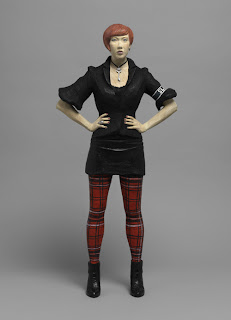
Part-finished crucifix figures, Upper Rhenish, c. 1500. Historisches Museum, Basle.
Which are most instructive for the shaping process, stripped down as they are to facets and an outline.
Technical thoughts:
Few of the facets are directly facing the viewer, which may contribute to the sense of jutting 3d form.
The mannered shins are , especially in the second figure, impossibly attenuated and give full play to the curved blade of the tibia. The tensile strength in the wood can be felt, as a tense, brittle stiffness. There is great discomfort in the toes. In each figure at the stage where the carving was abandoned the leg on our left is more curvaceous and expressive.The leg on our right in each case is cut very straight, perhaps to maximise the straight grain, and being behind, is more load-bearing.
The drapery is surprisingly well finished on the left, and would have been rather vulnerable during the remaining carving.


















































